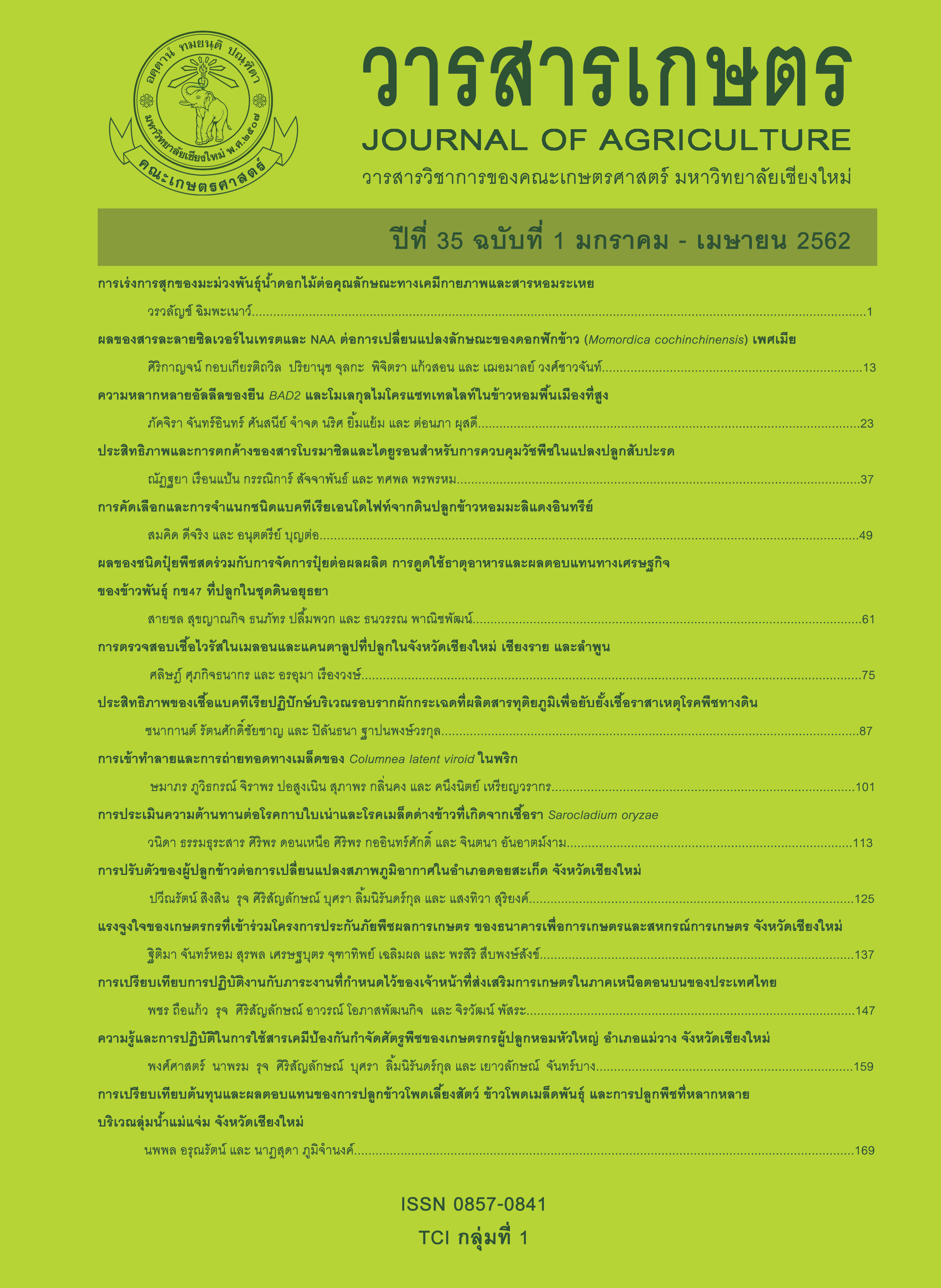การเข้าทำลายและการถ่ายทอดทางเมล็ดของ <I>Columnea latent viroid</I> ในพริก
Main Article Content
บทคัดย่อ
Columnea latent viroid (CLVd) สามารถเข้าทำลายพริก 6 พันธุ์ ที่นำมาศึกษาในครั้งนี้และเมื่อตรวจสอบด้วยเทคนิค reverse transcription-polymerase chain reaction (RT-PCR) พบว่ามีอัตราการเข้าทำลาย 67-100% โดยต้นพริกที่ติดเชื้อจะไม่แสดงอาการ หรือแสดงอาการหลังการติดเชื้ออย่างช้า ๆ ได้แก่ พริกขี้หนู (Capsicum frutescens) มีลักษณะอาการใบยอดผิดปกติ ปลายใบม้วนพับไปด้านหลังและมีขนาดลดลง ดอกผิดปกติและกลีบดอกมีสีเขียวอ่อนติดผลน้อยและไม่มีการพัฒนาของเมล็ดภายในผลหลังได้รับการปลูกเชื้อนาน 6 เดือน เมื่อศึกษาการถ่ายทอดทางเมล็ดของเชื้อไวรอยด์ในพริกหวาน 2 (Sweet pepper 2) ที่ตรวจพบการติดเชื้อของต้น 100% และมีการติดเมล็ด พบว่าเมื่อนำเมล็ดที่ได้ไปปลูกในสภาพโรงเรือน มีต้นพริกที่งอกจำนวนทั้งหมด 26 ต้นจากเมล็ดที่นำมาทดสอบ 100 เมล็ด (ความงอก 26%) เมื่อต้นพริกอายุครบ 10 สัปดาห์ นำใบมาตรวจหาเชื้อ CLVd ด้วยเทคนิค RT-PCR เพื่อยืนยันการถ่ายทอดผ่านทางเมล็ดสู่ต้นอ่อน ผลการตรวจพบ 16 ต้น จาก 26 ต้น ตรวจพบเชื้อ CLVd ซึ่งคิดเป็นอัตราการถ่ายทอดผ่านทางเมล็ดของเชื้อ CLVd ในพริกหวาน 2 ดังกล่าวเท่ากับ 61.5% จากงานทดลองนี้สามารถยืนยันได้ว่าเชื้อ CLVd สามารถถ่ายทอดทางเมล็ดพริกหวานได้ ส่งผลให้เกิดความเสี่ยงในการแพร่ระบาดของเชื้อ CLVd ในแปลงปลูกพริก เนื่องจากพริกส่วนใหญ่ไม่แสดงอาการทำให้ยากที่จะขจัดต้นติดเชื้อออกไปจากพื้นที่ปลูก ดังนั้นการใช้เมล็ดพันธุ์พริกที่ปลอดโรคจะสามารถควบคุมโรคที่เกิดจากเชื้อไวรอยด์ได้ดีที่สุด
Article Details
References
ปริเชษฐ์ ตั้งกาญจนภาสน์ คนึงนิตย์ เหรียญวรากร เสริมศิริ จันทร์เปรม และ รัชนี ฮงประยูร 2548. ไพรเมอร์สำหรับตรวจสอบไวรอยด์ที่ก่อให้เกิดโรคในมะเขือเทศ 6 ชนิดในกลุ่ม Pospiviroid ด้วยเทคนิค RT-PCR. วารสารโรคพืช 19: 13-21.
ปริเชษฐ์ ตั้งกาญจนภาสน์ วันเพ็ญ ศรีทองชัย กาญจนา วาระวิชะนี และ วันเพ็ญ ศรีชาติ 2554. การตรวจติดตามเชื้อ Columnea latent viroid (CLVd) ที่ติดเข้ามากับเมล็ดพันธุ์มะเขือเทศที่นำเข้าจากต่างประเทศ. หน้า 1570-1576. ใน: รายงานผลงานวิจัยประจำปี 2554. สำนักวิจัยพัฒนาการอารักขาพืช กรมวิชาการเกษตร, กรุงเทพฯ.
ปริเชษฐ์ ตั้งกาญจนภาสน์ วันเพ็ญ ศรีทองชัย กาญจนา วาระวิชะนี และ วันเพ็ญ ศรีชาติ 2555. การตรวจติดตามเชื้อ Columnea latent viroid (CLVd) ที่ติดเข้ามากับเมล็ดพันธุ์มะเขือเทศที่นำเข้าจากต่างประเทศ. หน้า 1859-1889. ใน: รายงานผลงานวิจัยประจำปี 2555. สำนักวิจัยพัฒนาการอารักขาพืช กรมวิชาการเกษตร, กรุงเทพฯ.
สมาคมการค้าเมล็ดพันธุ์ไทย. 2560. สถิตินำเข้า-ส่งออกเมล็ดพันธุ์ควบคุม. (ระบบออนไลน์). แหล่งข้อมูล: http://www.thasta.com/ web/index.php/2016-05-29-01-47-24/2016-05-29-01-48-39 (12 สิงหาคม 2560).
สวิตา สุวรรณรัตน์ ปัฐวิภา สงกุมาร Siegrid Steinkellner และ สมศิริ แสงโชติ 2560. การแสดงออกของยีนที่เกี่ยวข้องกับเอนไซม์ cutinase และ endopolygalacturonase ของเชื้อรา Colletotrichum capsici ในช่วงการเข้าทำลายบนผลพริก. วารสารเกษตร 33(3): 357-366.
ศศิประภา มาราช 2551. โคลนก่อโรคของเชื้อ Columnea latent viroid และผลกระทบต่อมะเขือเทศพันธุ์การค้า. วิทยานิพนธ์วิทยาศาสตรมหาบัณฑิต, มหาวิทยาลัยเกษตรศาสตร์. กรุงเทพฯ. 86 หน้า.
Diener, T. O. 1987. The Viroids. Plenum Press, Inc., New York. 344 p.
Fagoaga, C. and N. Duran-Vila. 1996. Naturally occurring variants of Citrus exocortis viroid in vegetable crops. Plant Pathology 45: 45-53.
Galindo, J.A., D.R. Smith and T.O. Diener. 1982. Etiology of planta macho, a viroid disease of tomato. Phytopathology 72: 49-54.
Hadidi, A., R. Flores, J.W. Randles and J.S. Semancik. 2003. Viroids. CSIRO Publishing, Collingwood, Vic. 370 p.
Hammond, R., D.R. Smith and T.O. Diener. 1989. Nucleotide sequence and proposed secondary structure of Columnea latent viroid: a natural mosaic of viroid sequences. Nucleic Acids Research 17: 10083-10094.
Lawson, R.H. 1987. Chrysanthemum stunt. pp. 247-259. In: T.O. Diener (ed.). The Viroids. Plenum Press, New York. 344 p.
Matsushita, Y. and S. Tsuda. 2015. Host ranges of Potato spindle tuber viroid, Tomato chlorotic dwarf viroid, Tomato apical stunt viroid and Columnea latent viroid in horticultural plants. European Journal of Plant Pathology 141: 193-197.
Matsushita, Y. and S. Tsuda. 2016. Seed transmission of Potato spindle tuber viroid, Tomato chlorotic dwarf viroid, Tomato apical stunt viroid and Columnea latent viroid in horticultural plants. European Journal of Plant Pathology 145: 1007-1011.
Mishra, M.D., R.W. Hammond, R.A. Owens, D.R. Smith and T.O. Diener. 1991. Indian bunchy top disease of tomato plants is caused by a distinct strain of Citrus exocortis viroid. Journal of General Virology 722: 1781-1785.
Nielsen, S.L. and M. Nicolaisen. 2010. First report of Columnea latent viroid (CLVd) in Gloxinia gymnostoma, G. nematanthodes and G. purpurascens in a botanical garden in Denmark. New Disease Reports 22: 4.
Nixon, T., R. Glover, S. Mathews-Berry, M. Daly, E. Hobden, C. Lambourne, V. Harju and A. Skelton. 2010. Columnea latent viroid (CLVd) in tomato: the first report in the United Kingdom. New Disease Reports 59: 392.
Owens, R.A., D.R. Smith and T.O. Diener. 1978. Measurement of viroid sequence homology by hybridization with complementary DNA prepared in vitro. Virology 89: 388-394.
Reanwarakorn, K., S. Klinkong and J. Porsoongnurn. 2011. First report of natural infection of Pepper chat fruit viroid in tomato plants in Thailand. New Disease Reports 24: 6.
Sano, T., L. Uyeda and E. Shikata. 1984. Comparative studies of Hop stunt viroid and Cucumber pale fruit viroid by polyacrylamide gel electrophoretic analysis and electron microscopic examination. Annual Phytopathology Society Japan 50: 339-345.
Shikata, E. 1987. Hop stunt. pp. 279-289. In: T.O. Diener (ed.). The Viroids. Plenum Press, New York. 344 p.
Singh, R.P. 1983. Viroids and their potential danger to potatoes in hot climates. Canadian Plant Disease Survey 63: 13-18.
Singh, R.P., X. Nie and M. Singh. 1999. Tomato chlorotic dwarf viroid: an evolutionary link in the origin of Pospiviroids. Journal of General Virology 80: 2823-2828.
Singh, R.P, D.K. Lakshman, A. Boucher and S. M. Tavantzis. 1992. A viroid from Nematanthus wettsteinii plants closely related to the Columnea latent viroid. Journal of General Virology 73: 2769-2774.
Spieker, R.L. 1996. A viroid from Brunfelsia undulata closely related to the Columnea latent viroid. Archives of Virology 141: 1823-1832.
Steyer, S., T. Olivier, A. Skelton, T. Nixon and E. Hobden. 2010. Columnea latent viroid (CLVd): first report in tomato in France. Plant Pathology 59: 794-794.
Verhoeven, J.T.J., C.C.C. Jansen, J.W. Roenhorst, R. Flores and M. de la Pena. 2009. Pepper chat fruit viroid: biological and molecular properties of a proposed new species of the genus Pospiviroid. Virus Research 144: 209-214.
Verhoeven, J.T.J., C.C.C. Jansen, T.M. Willemen, L. F.F. Kox, R.A. Owens and J.W. Roenhorst. 2004. Natural infections of tomato by Citrus exocortis viroid, Columnea latent viroid, Potato spindle tuber viroid and Tomato chlorotic dwarf viroid. European Journal of Plant Pathology 110: 823-831.
Verhoeven, J.T.J., R.A. Owens and J.W. Roenhorst. 2011. Mexican papita viroid and Tomato planta macho viroid belong to a single species in the genus Pospiviroid. Archives of Virology 156: 1433-1437.
Walter, B. 1987. Tomato apical stunt. pp. 321-327. In: T. O. Diener (ed.). The Viroids. Plenum Press, New York. 344 p.
Yanagisawa, H. and Y. Matsushita. 2017. Host ranges and seed transmission of Tomato planta macho viroid and Pepper chat fruit viroid. European Journal of Plant Pathology 149: 211-217.

